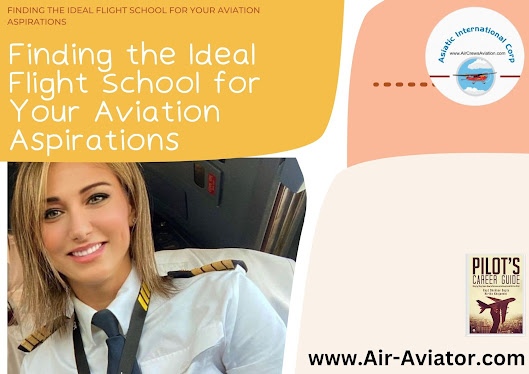Finding the Ideal Flight School for Your Aviation Aspirations ✈️ ✈️
www.Air-Aviator.com
Embarking on the journey to become a Pilot is an exciting endeavor, but choosing the right flight school can make all the difference in your Aviation career. With so many options available, it’s essential to carefully evaluate your choices to ensure that the school you select aligns with your Goals, learning style, and budget. Here’s a comprehensive guide to help you navigate this critical Decision.
1. Define Your Goals 🎯
Before you begin your search, take a moment to clarify your career objectives. Are you pursuing a private Pilot’s license (PPL) for recreational flying, or are you aiming for a career in commercial Aviation? Understanding your end Goal will help you identify schools that offer the right programs and certifications to meet your needs.
For instance, if you’re targeting a career as an airline Pilot, look for schools that provide comprehensive training, including instrument ratings, multi-engine training, and partnerships with airlines. On the other hand, if your Goal is recreational flying, a smaller school focused on PPL might suffice.
2. Research Accreditation and Certifications 📜
Ensure the flight school is accredited by relevant Aviation authorities. In the United States, for example, the Federal Aviation Administration (FAA) regulates and certifies flight schools. In other countries, similar regulatory bodies oversee Aviation training. Accreditation ensures that the school adheres to industry standards and provides quality education.
Also, check whether the school offers Part 61 or Part 141 training. Part 61 programs offer more flexibility, while Part 141 programs are structured and often faster-paced. Your choice will depend on your learning style and schedule.
3. Evaluate the Fleet and Facilities 🛩️
The quality and availability of aircraft can significantly impact your training experience. Visit the flight school to inspect their fleet—modern, well-maintained planes are a must for safe and effective training. Additionally, ask about the availability of aircraft. A larger fleet may reduce scheduling conflicts, allowing you to complete your training more efficiently.
Equally important are the facilities. A school with modern simulators, well-equipped classrooms, and a dedicated maintenance team demonstrates a commitment to excellence in training.
4. Review the Curriculum and Training Methods 📚
Flight schools differ in their teaching methodologies. Some emphasize traditional classroom instruction, while others incorporate advanced technology like virtual reality simulators. Determine which approach suits you best.
Request a detailed curriculum to ensure that it covers all necessary aspects of flight training. Look for schools that go beyond the basics and offer training in areas like emergency procedures, cross-country navigation, and real-world weather scenarios.
5. Assess Instructor Experience 👨🏫
The quality of your instructors will heavily influence your learning experience. Look for schools with highly qualified, experienced, and approachable flight instructors. During your visit, ask about instructor-to-student ratios. Smaller class sizes generally allow for more personalized instruction.
6. Consider Location and Weather ☀️🌧️
Geographic location plays a crucial role in flight training. Schools in regions with favorable weather conditions often allow for year-round flying, helping you complete your training faster. Conversely, training in diverse weather conditions can better prepare you for real-world flying challenges.
Additionally, consider the cost of living in the area. While some schools might have lower tuition, they could be located in cities with higher living expenses.
7. Analyze Costs and Financial Aid Options 💰
Flight training is a significant financial investment, so it’s vital to understand all associated costs upfront. Tuition, aircraft rental fees, instructor fees, and additional expenses like books and exam fees should all be factored into your budget.
Many schools offer financial aid, scholarships, or payment plans to ease the burden. Research these options thoroughly and ask about any hidden costs that might arise during your training.
8. Seek Reviews and Recommendations 🌟
Online reviews, forums, and testimonials can provide valuable insights into the reputation and quality of a flight school. Reach out to current or former students to get an honest perspective on their experiences.
Additionally, networking within the Aviation community can help you uncover recommendations. Attend Aviation expos, join Pilot groups, or consult with professional Pilots to gather their input.
9. Visit the School and Take a Discovery Flight 👀✈️
Nothing beats experiencing the school firsthand. Schedule a visit to tour the facilities, meet the instructors, and observe the overall atmosphere. Many schools offer a discovery flight—a trial lesson that gives you a taste of what to expect. This experience can be instrumental in determining if the school is the right fit for you.
10. Look for Career Placement Support 💼
If your Goal is to become a professional Pilot, consider schools that offer career placement services. Schools with strong industry connections and airline partnerships can give you a significant advantage in securing a job post-graduation.
Choosing the right flight school is a pivotal step in your journey to becoming a Pilot. By defining your Goals, Researching thoroughly, and evaluating all aspects of potential schools, you’ll be better equipped to make an informed Decision. Remember, the right school isn’t just about the curriculum or fleet—it’s about finding a supportive environment that nurtures your passion for flying and sets you up for a successful Aviation career. 🚀
Shrishty Sharma
Manager HR/ Author
Asiatic International Corp
Shrishty@Flying-Crews.com
Shrishty@AsiaticIncorp.com
LinkedIn :
Link tree: https://linktr.ee/Shrishty_HRM_Flying_Crews
Vcard:
https://www.qrcodechimp.com/page/sjft4kd2k77n?v=chk1733391778
FB: https://www.instagram.com/flyingcrewhrm
YouTube :
https://www.youtube.com/aerosoftcorp




Comments
Post a Comment